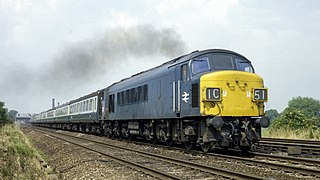
The British Rail Class 03 locomotive was, together with the similar Class 04, one of British Railways' most successful 0-6-0 diesel-mechanical shunters. 230 were built at Doncaster and Swindon works between 1957 and 1962, and were numbered D2000-D2199 and D2370-D2399. D2370 and D2371 were used as departmental locomotives and originally numbered 91 and 92 respectively.

The British Rail Class 04 is a 0-6-0 diesel-mechanical shunting locomotive class, built between 1952 and 1962 and was the basis for the later Class 03 built in the British Railways workshops.

The British Rail Class 05 is a class of 0-6-0 diesel-mechanical shunters built by Hunslet Engine Company from 1955 to 1961. They were used on the Eastern and Scottish Regions of British Railways. The first two batches were delivered as 11136-11143 and 11161-11176. Subsequent locomotives were delivered, new, as D2574-D2618.

The British Rail Class 07 diesel locomotive is an off-centre cab 0-6-0 diesel-electric shunter type built by Ruston & Hornsby in 1962 for the Southern Region of British Railways. The 14 members of the class were primarily used at Southampton Docks and later also at Eastleigh Works.

The British Rail Class 08 is a class of diesel-electric shunting locomotives built by British Railways (BR). As the standard BR general-purpose diesel shunter, the class became a familiar sight at major stations and freight yards. Since their introduction in 1952, however, the nature of rail traffic in Britain has changed considerably. Freight trains are now mostly fixed rakes of wagons, and passenger trains are mostly multiple units or have Driving Van Trailers, neither requiring the attention of a shunting locomotive. Consequently, a large proportion of the class has been withdrawn from mainline use and stored, scrapped, exported or sold to industrial or heritage railways.

The British Rail Class 11 was applied to a batch of diesel shunting locomotives built from April 1945 to December 1952, based on a similar earlier batch built by the London, Midland and Scottish Railway (LMS) between 1934 and 1936.
Brush Traction was a manufacturer and maintainer of railway locomotives in Loughborough, England whose operations have now been merged into the Wabtec company's Doncaster UK operations.

The Hunslet Engine Company is a locomotive-building company, founded in 1864 in Hunslet, England. It manufactured steam locomotives for over 100 years and currently manufactures diesel shunting locomotives. The company is part of Ed Murray & Sons Ltd.
Before the TOPS Class 97 was issued to self-propelled locomotives in departmental use, British Rail had such locomotives numbered in a variety of series, together with locomotives that were no longer self-propelled. See Also:

The British Railways Class D3/7 is a class of 0-6-0 diesel electric shunting locomotives built as LMS Nos. 7080–7119. The class were built from May 1939 through to July 1942 by the London, Midland and Scottish Railway at their Derby Works using a diesel electric transmission supplied by English Electric.

The British Rail Class D2/11 was a British class of locomotive designed in 1958 by Brush Traction and Beyer, Peacock & Company, which co-operated to produce five prototype diesel-electric shunting locomotives of 0-4-0 wheel arrangement. They were intended to demonstrate a new generation of diesel shunters for industrial and mainline use. Two were loaned to British Railways for trials and one, number D2999, was subsequently purchased by BR. However, no large scale orders resulted from these demonstrators.

The North British Locomotive Company was created in 1903 through the merger of three Glasgow locomotive manufacturing companies; Sharp, Stewart and Company, Neilson, Reid and Company and Dübs and Company, creating the largest locomotive manufacturing company in Europe and the British Empire.

The British Rail Class 43 (HST) is the TOPS classification used for the InterCity 125 High Speed Train (formerly Classes 253 and 254) diesel-electric power cars, built by British Rail Engineering Limited from 1975 to 1982, and in service in the UK since 1976.

The British Rail Class 45 or Sulzer Type 4 are diesel locomotives built by British Railways' Derby and Crewe Works between 1960 and 1962. Along with the similar Class 44 and 46 locomotives, they became known as Peaks.
British Rail Class D2/1 was a locomotive commissioned by British Rail in England. It was a diesel powered locomotive in the pre-TOPS period built by the North British Locomotive Company with a Paxman engine. Eight locomotives were built and they were numbered D2700-D2707.

The British Rail Class D2/5 was a locomotive commissioned by British Rail in England. It was a diesel powered locomotive in the pre-TOPS period built by Andrew Barclay with a Gardner engine.

British Rail Class D2/12 was a class of ten locomotives commissioned by British Railways in England. They were diesel powered locomotives in the pre-TOPS period built by Hudswell Clarke with a Gardner engine. The mechanical transmission, using a scoop control fluid coupling and four-speed Power-flow SSS (synchro-self-shifting) gearbox, was a Hudswell Clarke speciality.

Neville Hill is a railway train maintenance depot in Osmondthorpe, Leeds, England on the Leeds to Selby Line. The depot is situated 2 miles 14 chains (3.5 km) to the east of Leeds railway station on the north side of the line.
Heritage Shunters Trust (HST) is a trading name of The South Yorkshire Railway Co. Ltd. which was founded in 1989.














